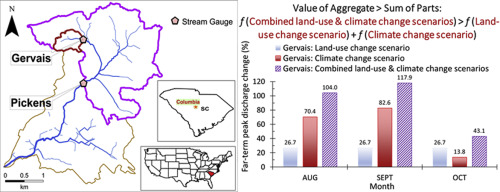当前位置:
X-MOL 学术
›
Ecol. Eng.
›
论文详情
Our official English website, www.x-mol.net, welcomes your feedback! (Note: you will need to create a separate account there.)
Impacts of combined land-use and climate change on streamflow in two nested catchments in the Southeastern United States
Ecological Engineering ( IF 3.8 ) Pub Date : 2020-01-01 , DOI: 10.1016/j.ecoleng.2019.105665 Chen-Ling J. Hung , L. Allan James , Gregory J. Carbone , John M. Williams
Ecological Engineering ( IF 3.8 ) Pub Date : 2020-01-01 , DOI: 10.1016/j.ecoleng.2019.105665 Chen-Ling J. Hung , L. Allan James , Gregory J. Carbone , John M. Williams

|
Abstract Stream restoration aims to improve hydrologic, geomorphic, and ecological processes and provides an opportunity for ecological design in an urban context. Urban stream restoration and stormwater management involve conventional and low impact development strategies that may employ ecological engineering techniques. Urban flood-risks may increase rapidly due to the combination of land-use and climate change. This is a major research frontier because the changes are poorly understood, especially for the combined impacts of climate and land-use change in small catchments. Climate and land-use change may affect hydrologic systems in a complex, non-linear, and non-additive manner. Streamflow simulation models can measure the relative magnitude of land-use and climate change on hydrologic response to precipitation events. Based on a simulation model calibrated with instrumental rainfall and streamflow data, this study compares simulated urban stormflow response to projected land-use and climate change in two highly urbanized catchments in Columbia, South Carolina, USA, using the U.S. Environmental Protection Agency (EPA)’s Storm Water Management Model (SWMM). Runoff responses for moderate-magnitude storms are contrasted using three land-use change scenarios with differing imperviousness and three climate-change scenarios. Land-use effects on runoff were proportionally greater in the smaller of the two catchments. At the headwater and downstream gauges, a warm/wet climate-change scenario caused larger increases than land-use changes in peak discharges and total event runoff volumes from late spring to early fall. The maximum monthly increase in peak discharge and total runoff volume from all simulations of climate change was for the warm/wet climate scenario in both catchments. However, the combined climate and land-use change scenario produced a 117.9% increase in peak discharge, a slightly (up to 8.6% in September) greater increase in peak discharge than the sum of changes from the individual scenarios (82.6% from climate change and 26.7% from land-use change) at the headwater gauge for the far term (2045–2074). These results suggest a complexity and nonlinearity of the impacts of combined land-use and climate change on hydrological processes, and have implications for stream restoration projects, integrated climate-impact assessments, urban planning, and policy decisions related to storm runoff and water quality.
中文翻译:

联合土地利用和气候变化对美国东南部两个嵌套集水区河流流量的影响
摘要 河流恢复旨在改善水文、地貌和生态过程,并为城市环境中的生态设计提供机会。城市河流恢复和雨水管理涉及可能采用生态工程技术的常规和低影响开发策略。由于土地利用和气候变化的共同作用,城市洪水风险可能会迅速增加。这是一个主要的研究前沿,因为人们对这些变化知之甚少,尤其是小流域气候和土地利用变化的综合影响。气候和土地利用变化可能以复杂、非线性和非累加的方式影响水文系统。流量模拟模型可以测量土地利用和气候变化对降水事件的水文响应的相对幅度。本研究基于使用仪器降雨和水流数据校准的模拟模型,使用美国环境保护署 (EPA),比较了美国南卡罗来纳州哥伦比亚两个高度城市化集水区的模拟城市风暴流响应与预计的土地利用和气候变化的雨水管理模型 (SWMM)。使用具有不同不渗透性的三种土地利用变化情景和三种气候变化情景来对比中等强度风暴的径流响应。在两个流域中较小的一个流域中,土地利用对径流的影响成比例地更大。在源头和下游水位,暖/湿气候变化情景导致峰值流量和从晚春到初秋的总事件径流量的增加大于土地利用变化。来自所有气候变化模拟的峰值流量和总径流量的最大月增长是针对两个流域的温暖/潮湿气候情景。然而,气候和土地利用变化组合情景产生了 117.9% 的峰值排放量增加,峰值排放量的增幅略高于(9 月份高达 8.6%)高于单个情景的变化总和(82.6% 来自气候变化)和 26.7% 来自土地利用变化)在远期(2045-2074 年)的源头水位。这些结果表明土地利用和气候变化对水文过程的影响具有复杂性和非线性,并且对河流恢复项目、综合气候影响评估、城市规划以及与风暴径流和水质相关的政策决策具有影响。
更新日期:2020-01-01
中文翻译:

联合土地利用和气候变化对美国东南部两个嵌套集水区河流流量的影响
摘要 河流恢复旨在改善水文、地貌和生态过程,并为城市环境中的生态设计提供机会。城市河流恢复和雨水管理涉及可能采用生态工程技术的常规和低影响开发策略。由于土地利用和气候变化的共同作用,城市洪水风险可能会迅速增加。这是一个主要的研究前沿,因为人们对这些变化知之甚少,尤其是小流域气候和土地利用变化的综合影响。气候和土地利用变化可能以复杂、非线性和非累加的方式影响水文系统。流量模拟模型可以测量土地利用和气候变化对降水事件的水文响应的相对幅度。本研究基于使用仪器降雨和水流数据校准的模拟模型,使用美国环境保护署 (EPA),比较了美国南卡罗来纳州哥伦比亚两个高度城市化集水区的模拟城市风暴流响应与预计的土地利用和气候变化的雨水管理模型 (SWMM)。使用具有不同不渗透性的三种土地利用变化情景和三种气候变化情景来对比中等强度风暴的径流响应。在两个流域中较小的一个流域中,土地利用对径流的影响成比例地更大。在源头和下游水位,暖/湿气候变化情景导致峰值流量和从晚春到初秋的总事件径流量的增加大于土地利用变化。来自所有气候变化模拟的峰值流量和总径流量的最大月增长是针对两个流域的温暖/潮湿气候情景。然而,气候和土地利用变化组合情景产生了 117.9% 的峰值排放量增加,峰值排放量的增幅略高于(9 月份高达 8.6%)高于单个情景的变化总和(82.6% 来自气候变化)和 26.7% 来自土地利用变化)在远期(2045-2074 年)的源头水位。这些结果表明土地利用和气候变化对水文过程的影响具有复杂性和非线性,并且对河流恢复项目、综合气候影响评估、城市规划以及与风暴径流和水质相关的政策决策具有影响。


























 京公网安备 11010802027423号
京公网安备 11010802027423号